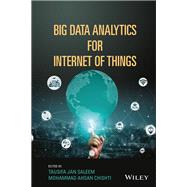Discover the latest developments in IoT Big Data with a new resource from established and emerging leaders in the field
Big Data Analytics for Internet of Things delivers a comprehensive overview of all aspects of big data analytics in Internet of Things (IoT) systems. The book includes discussions of the enabling technologies of IoT data analytics, types of IoT data analytics, challenges in IoT data analytics, demand for IoT data analytics, computing platforms, analytical tools, privacy, and security.
The distinguished editors have included resources that address key techniques in the analysis of IoT data. The book demonstrates how to select the appropriate techniques to unearth valuable insights from IoT data and offers novel designs for IoT systems.
With an abiding focus on practical strategies with concrete applications for data analysts and IoT professionals, Big Data Analytics for Internet of Things also offers readers:
- A thorough introduction to the Internet of Things, including IoT architectures, enabling technologies, and applications
- An exploration of the intersection between the Internet of Things and Big Data, including IoT as a source of Big Data, the unique characteristics of IoT data, etc.
- A discussion of the IoT data analytics, including the data analytical requirements of IoT data and the types of IoT analytics, including predictive, descriptive, and prescriptive analytics
- A treatment of machine learning techniques for IoT data analytics
Perfect for professionals, industry practitioners, and researchers engaged in big data analytics related to IoT systems, Big Data Analytics for Internet of Things will also earn a place in the libraries of IoT designers and manufacturers interested in facilitating the efficient implementation of data analytics strategies.









